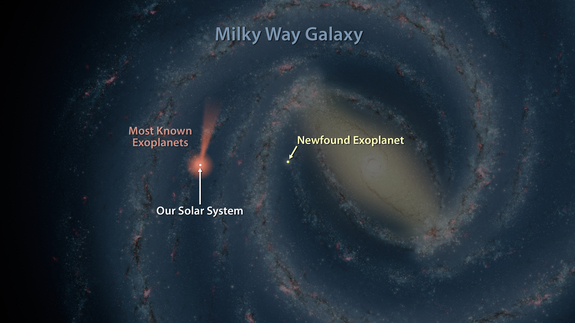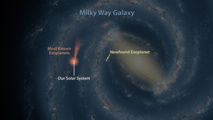Thestrategist.com – 22 April 2015 – Space.com reports about N.A.S.A’s new found discovery. The “Spitzer Space Telescope” of N.A.S.A. has co-located an extra solar planet situated “more than 13,000 light years” away from planet earth. In fact, the said “exo-planet” is the furthest to be ever reported.
The recently spotted exo-planet by N.A.S.A. telescope has been identified as “a gas giant”. The ‘Spitzer Space Telescope’ used the technique of “microlensing” whereby it has contributed to the discovery of thirty planets up till now. According to a statement given by N.A.S.A., the potential of the “Spitzer Space” telescope to locate “far-away worlds is vast”. The astronomers are in the process of charting the positions of these celestial bodies in reference to the planet earth in order to get:
The recently spotted exo-planet by N.A.S.A. telescope has been identified as “a gas giant”. The ‘Spitzer Space Telescope’ used the technique of “microlensing” whereby it has contributed to the discovery of thirty planets up till now. According to a statement given by N.A.S.A., the potential of the “Spitzer Space” telescope to locate “far-away worlds is vast”. The astronomers are in the process of charting the positions of these celestial bodies in reference to the planet earth in order to get:
“...a sense of where planets are distributed in Earth's Milky Way galaxy.”
An astrophysicist at the “Harvard-Smithsonian Centre”, Jennifer Yee, who is also the “lead author” in “one of the three” research papers written on the recent discovery of extra solar planets, informed on behalf of N.A.S.A.:
"We don't know if planets are more common in our galaxy's central bulge or the disk of the galaxy, which is why these observations are so important."
The process of microlensing takes place at the time when one star crosses the path of an observer, observing another star. At that moment, the star’s gravity that is situated in the front of the observer’s ken magnifies the light that comes from the star placed behind it; thus it serves the purpose of a lens. N.A.S.A. also stated that if there is a planet along with the star that comes in front, the former “would create a ‘blip’ during the magnification”.
Furthermore, the challenge involved in the said process lies in identifying the distance of the intersecting star and its planet vis-a-vis the earth. Mostly, the star that comes in front is not visible to the observer’s eye as the microlensing has a tendency to magnify the star that is situated at the background. Consequently, the distance that lies between the earth and almost fifty percent of planets, including the ones that appear like a Tatooine, discovered by microlensing methods are unknown to the scientists.
Thus, the ‘Spitzer’ telescope was introduced in the “Warsaw Telescope” situated “at the Las Campanas Observatory” in order to solve the distance-determination problem. The said experiment, namely “the Polish Optical Gravitational Lensing Experiment”, in short O.G.L.E, was conducted at Chile. Moreover, this has been the very first time when Spitzer was used to successfully locate a planet, although O.G.L.E. has been conducted “long-running” routine “microlensing investigations”.
Elizabeth Howell, a contributor of Space.com, writes:
“Prominent telescopes like Spitzer are usually fully booked with other astronomical observations. This makes it difficult to respond quickly when the astronomical community is alerted about a microlensing event, which lasts only 40 days on average. Spitzer officials, however, have worked to do these observations as early as three days after an event is announced.”
The recent microlensing-event lasted for almost 150 days while the Spitzer, as usual, was orbiting the sun from a trajectory that is greater than the earth. Consequently, it gets positioned behind the earth resulting in a time lag between an event seen from the earth and by the telescope. Owing to this delay, the astronomers were able to calculate the distance between the earth and the newly discovered planet. Space.com writes:
“Astronomers are using the microlensing events to seek out planets in the central "bulge" of the Milky Way, a spot where stars are more densely packed and tend to cross more often.”



















